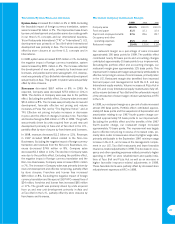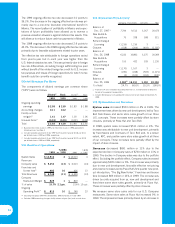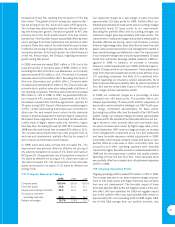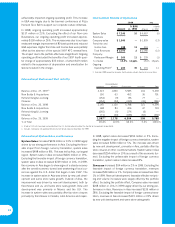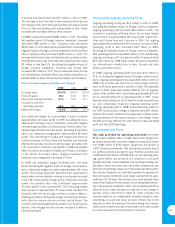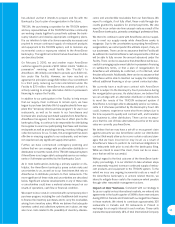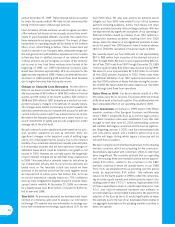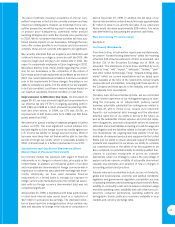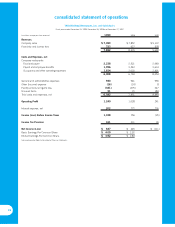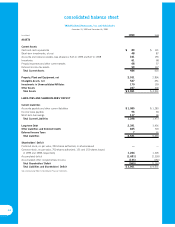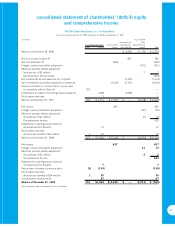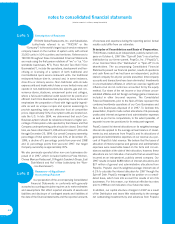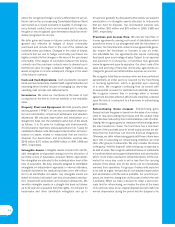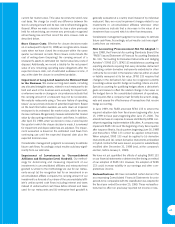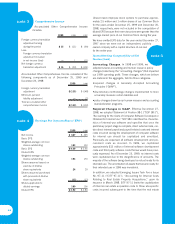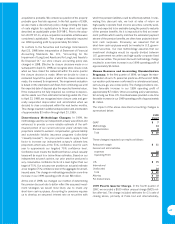Pizza Hut 1999 Annual Report Download - page 39
Download and view the complete annual report
Please find page 39 of the 1999 Pizza Hut annual report below. You can navigate through the pages in the report by either clicking on the pages listed below, or by using the keyword search tool below to find specific information within the annual report.
The pace of ultimate consumer acceptance of and our com-
petitors’ responses to the Euro are currently unknown and may
impact our existing plans. However, we know that, from a com-
petitive perspective, we will be required to assess the impacts
of product price transparency, potentially revise product
bundling strategies and create Euro-friendly price points prior
to 2002. We do not believe that these activities will have sus-
tained adverse impacts on our businesses. Although the Euro
does offer certain benefits to our treasury and procurement
activities, these are not currently anticipated to be significant.
We currently anticipate that our suppliers and distributors will
continue to invoice us in legacy currencies until late 2001. We
expect to begin dual pricing in our restaurants in 2001. We
expect to compensate employees in Euros beginning in 2002.
We believe that the most critical activity regarding the conver-
sion for our businesses is the completion of the rollout of
Euro-ready point-of-sale equipment and software by the end of
2001. Our current plans should enable us to be Euro-compliant
prior to the requirements for these changes. Any delays in our
ability to complete our plans, or in the ability of our key suppliers
to be Euro-compliant, could have a material adverse impact on
our results of operations, financial condition or cash flows.
Improvement in Effective Tax Rate. As discussed on
pages 29–30, we have achieved significant improvements in
our effective tax rate (“ETR”) on ongoing operating profit in
both 1999 and 1998 as a result of several tax planning initia-
tives and other events. In 1999, our ETR was 39.3%, an
improvement of 300 basis points from 1998 and 590 basis
points better than 1997.
We continue to pursue a variety of initiatives designed to further
reduce our ETR. The most significant current initiative is to
become eligible to claim foreign income tax credits against our
U.S. income tax liability on foreign sourced income. When it
becomes more likely than not that we will be able to claim the
benefit of foreign tax credits, which is reasonably possible in
2000, it should result in a further improvement in our ETR.
Quantitative and Qualitative Disclosures About
Market Risk of Financial Instruments
Our primary market risk exposure with regard to financial
instruments is to changes in interest rates, principally in the
United States. In addition, an immaterial portion of our debt
and receivables are denominated in foreign currencies which
exposes us to market risk associated with exchange rate move-
ments. Historically, we have used derivative financial
instruments on a limited basis to manage our exposure to
foreign currency rate fluctuations since the market risk associ-
ated with our foreign currency denominated debt was not
considered significant.
At December 25, 1999, a hypothetical 100 basis point increase
in short-term interest rates would result in a reduction of
$12 million in annual pre-tax earnings. The estimated reduc-
tion is based upon the unhedged portion of our variable rate
debt and assumes no change in the volume or composition of
debt at December 25, 1999. In addition, the fair value of our
interest rate derivative contracts would increase approximately
$7 million in value to us, and the fair value of our unsecured
Notes would decrease approximately $28 million. Fair value
was determined by discounting the projected cash flows.
New Accounting Pronouncement
See Note 2.
Cautionary Statements
From time to time, in both written reports and oral statements,
we present “forward-looking statements” within the meaning
of Section 27A of the Securities Act of 1933, as amended, and
Section 21E of the Securities Exchange Act of 1934, as
amended. The statements include those identified by such
words as “may,” “will,” “expect,” “anticipate,” “believe,” “plan”
and other similar terminology. These “forward-looking state-
ments” reflect our current expectations and are based upon
data available at the time of the statements. Actual results
involve risks and uncertainties, including both those specific to
the Company and those specific to the industry, and could dif-
fer materially from expectations.
Company risks and uncertainties include, but are not limited
to, the limited experience of our management group in oper-
ating the Company as an independent, publicly owned
business; potentially substantial tax contingencies related to
the Spin-off, which, if they occur, require us to indemnify
PepsiCo; our substantial debt leverage and the attendant
potential restriction on our ability to borrow in the future, as
well as the substantial interest expense and principal repay-
ment obligations; potential unfavorable variances between
estimated and actual liabilities including accruals for wage and
hour litigation and the liabilities related to the sale of the Non-
core Businesses; the ongoing business viability of our key
distributor of restaurant products and equipment in the United
States and our ability to ensure adequate supply of restaurant
products and equipment in our stores; our ability to complete
our conversion plans or the ability of our key suppliers to be
Euro-compliant; our potential inability to identify qualified fran-
chisees to purchase restaurants at prices we consider
appropriate under our strategy to reduce the percentage of
system units we operate; volatility of actuarially determined
casualty loss estimates and adoption of new or changes in
accounting policies and practices.
Industry risks and uncertainties include, but are not limited to,
global and local business, economic and political conditions;
legislation and governmental regulation; competition; success
of operating initiatives and advertising and promotional efforts;
volatility of commodity costs and increases in minimum wage
and other operating costs; availability and cost of land and con-
struction; consumer preferences, spending patterns and
demographic trends; political or economic instability in local
markets and currency exchange rates.
37


